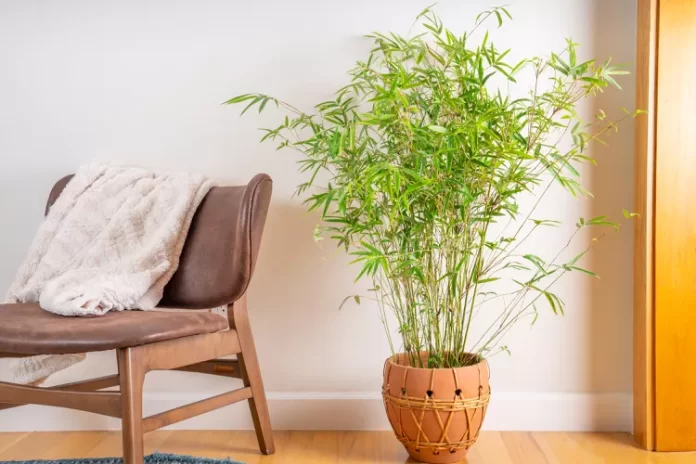Golden bamboo (Phyllostachys aurea) is one of a few bamboo plants that can grow inside. Most bamboos require a lot of sun and humidity to grow well, which is not easy to achieve for indoor plants. Many confuse “lucky bamboo” plant (Dracaena species), a smaller bamboo-looking plant that grows in water, as an easy-growing indoor bamboo plant, but it is not a bamboo plant.
Bamboo has over a thousand plant species, and several tower 50 feet or more in the wild. Golden bamboo is a true bamboo with bright green upright canes that turn golden with age and sunlight. It has narrow, lance-shaped leaves growing in clusters on short stems from canes.
Golden bamboo grows quickly and can easily spread. It’s best planted in the spring or early fall, though indoors, you generally can plant it any time of year. Potting bamboo keeps it contained and more manageable. Indoors, it won’t grow as large, usually about 5 to 8 feet tall.
| Common Names | Bamboo, golden bamboo, fishpole bamboo, monk’s belly bamboo, fairyland bamboo |
| Botanical Name | Phyllostachys aurea |
| Plant Type | Perennial, rhizome, grass |
:max_bytes(150000):strip_icc():format(webp)/how-to-grow-golden-bamboo-5077107-03-4f9088812ad048aaa90394c6fc43f68f.jpg)
Can You Grow Golden Bamboo Inside?
This plant can be grown indoors, but growing bamboo inside is not easy. To grow bamboo successfully indoors, you need a sturdy container and ample light and humidity. Bamboo needs at least 6 hours of light to thrive.
Put bamboo in your sunniest window. Depending on the type, it can grow up to 8 feet tall; lower light usually means slower and less growth.
Other common varieties that grow indoors in containers include Pleioblastus viridistriatus (dwarf green stripe bamboo) and Pseudosasa japonica (arrow bamboo).
- Dwarf green stripe bamboo grows to 4 feet tall but usually stays about 2 1/2 feet tall indoors.
- Arrow bamboo grows taller, does well in shade or full sun, and can thrive in shade better than most bamboo species.
How to Grow Golden Bamboo Indoors
Regular watering and feeding will make up most of your plant maintenance for growing bamboo indoors. To maintain the soil moisture level that bamboo likes, you might have to water your container plant more than once a week. But especially for an indoor plant where the climate stays constant, you should be able to establish a predictable care routine reasonably easily.
Sunlight
Outdoors, bamboo prefers a spot that gets full sun to partial shade. Indoors, keep your bamboo by your brightest window to get natural sunlight, and rotate the pot weekly to ensure all sides of the plant get light.
If it’s too shady for bamboo, the plant will become weak, not growing to its fullest potential or developing its brilliant color. It should not need supplemental or artificial lighting as long as it’s placed in a sunny window.
Temperature and Humidity
Golden bamboo is known for its cold tolerance. It can survive temperatures down to 5 degrees Fahrenheit for a short time. However, prolonged cold weather can cause the plant to drop foliage and might eventually kill it.
The plant prefers typical room temperatures between 60 and 80 degrees Fahrenheit. Keep it away from air conditioner and heater vents. The cold drafts from an air conditioner or drying heater vents can weaken the plant. These plants thrive in humid air but have adapted to indoor dryness if watered well. Most bamboos prefer a humidity level of 50% to thrive.
Watering
Bamboo has some drought tolerance once established and can handle soggy soil in short bursts. However, sitting in pooled water can rot the roots and kill the plant.
The plant ideally should have evenly moist soil. Test the soil by sticking your finger an inch or two in it and watering it whenever it feels dry. Never let the soil dry out completely. But during the winter months, slightly cut back on watering.
Fertilizer
Feed your bamboo a balanced liquid fertilizer once a month to maintain optimal nutrients in your container plant’s soil, following label instructions. It also can be helpful to mix some organic compost into the soil, especially in the spring, to promote healthy plant growth.
Pruning and Maintenance
Bamboo typically doesn’t require pruning. You can remove old canes at their base if they begin to look unsightly. Remove new shoots as they pop up from the soil to limit your plant’s growth and spread.
Container and Size
Consider getting a metal or hardwood container since bamboo can break through plastic or terra-cotta, and ensure it has ample drainage holes. Pick a heavy pot so that it can anchor the weight of the bamboo canes.
You will need at least a 10-gallon container to start. And if you don’t want to repot it yearly, begin with a 20- or 30-gallon pot. Bamboo tends to send runners, which likes a pot that is wider versus deep. Clumping types of bamboo do better in a container with equal dimensions.
Potting Soil and Drainage
This plant tolerates various soil types but prefers organically rich soil with good drainage. It does not like soggy soil. A commercial potting mix or a mixture of peat moss and perlite should be fine for container plants.
Potting and Repotting Golden Bamboo
When starting with a small nursery bamboo plant, you can use a pot that is 12 inches wide and deep. You can add rocks or gravel to the bottom of the pot to anchor the plant’s weight. Place the root ball in the pot and fill it around it with a loose, nutrient-rich potting mix. You can mix in some compost to encourage growth. Then, water the bamboo well.
You might need to move your bamboo to a larger pot every year or two once the roots have spread through the entire pot and you see them coming out of the holes in the bottom or poking up out of the soil on top.
Don’t allow your plant to remain in a pot that’s too small for very long, as it won’t get enough nutrients to stay healthy. An indoor plant typically will do fine being repotted at any time of year, but the start of the growing season in the spring, when the plant is revving up its growth, is generally the best time for repotting.
Moving Golden Bamboo Outdoors for the Summer
Bamboo does its best growing outdoors; hence, it can move outdoors for the warmer months.
Considerations
Considering golden bamboo can grow up to 20-plus feet tall, you might not want your plant to grow vigorously taller than your ceilings can accommodate. Outdoor conditions are closer to ideal, making overgrowth a risk.
If you want to move it outdoors, slowly acclimate bamboo to outdoor conditions. The sun will be stronger, and the temperature swing may also stress the plant. Only bring it outside when temperatures are consistently around 60 F to 80 F, similar to indoors.
To harden off the plant or acclimate it, bring it out for one to two hours at a time for a week, then gradually increase by three to four hours the following week, slowly adding more time each week.
Start by placing the plant in a partial sun spot in the first few weeks. Full sun might be too much for the plant to handle in the first few weeks of going outdoors. Also, the plant does not like soggy soil, so ensure your plant has well-draining soil and ample drainage holes to accommodate rainy outdoor days.
When to Bring Golden Bamboo Back Inside
Once temperatures start going down to the 50s F, it’s time to begin acclimating the plant for returning indoors. Bring the plant indoors for two hours a day for a week, gradually increasing its time inside each week. Also, bring plants inside if there’s an unexpected cold snap or massive temperature swing.
Intense temperature fluctuations can stress a plant, causing leaves to wilt or droop. Moving the plant to a warmer spot can remedy this temporary response. A sudden leaf drop indicates the plant is experiencing extreme temperature stress.
FAQ
- How long does indoor bamboo live? Outdoors, a bamboo stand can live up to 100 years, but the average lifespan of an individual bamboo plant is about 7 to 10 years. Bamboo stands proliferate new growth yearly, making it seem like a bamboo plant is eternal. Because it’s hard to replicate its native environment indoors, golden bamboo plants will typically have a shorter lifespan, usually less than 10 years.
- What are popular Phyllostachys aurea varieties of bamboo? ‘Flavescens Inversa’ has a yellow stripe on the lower portion of its canes. ‘Holochrysa’ canes turn golden faster than others of the species. ‘Koi’ canes turn yellow with green stripes.
- Why are bamboo leaves turning yellow? The most common reason for yellowing leaves is too much sunlight or salty or fluoridated tap water. Water with filtered water and reduce sun exposure.
- Does bamboo flower? Yes, bamboo blooms with 2-inch spikelets with nearly a dozen flowers, but their intervals vary by species or type. Some bamboo varieties flower annually, while others will not for over 100 years. Golden bamboo rarely blooms; when it does, it can take decades. The likelihood of golden bamboo flowering indoors is very low.


